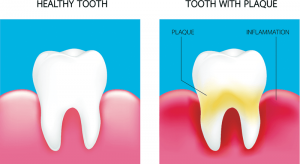By Dr. Salina Suy
Editor’s note: This is another segment in a continuing series titled, “Defining Dentistry,” designed to enlighten readers on various components of dentistry.
April showers bring May flowers — at least I hope so, anyways!
April always seems like winter still to me, and I am hoping this April truly gives us the spring weather we deserve.
Honestly, I love having four true seasons, but only because of the fashion.
Thank you again for joining in on this month’s “Smile with Dr. Suy” and our continuing series, “Defining Dentistry.”
Our column subject this month is dental plaque and tartar.
We all have heard the terms before — plaque and tartar. Now, let’s discover the mystery.
What is dental plaque?
You know when after you eat something, you slide your tongue over your teeth and you can feel the spots that are silky smooth and then there are spots that are a little “gritty”?
This is dental plaque. Dental plaque starts developing as soon as you eat food; it is the thin layer of food left behind. It is quite common in kids dentistry as dental hygiene can fall by the wayside with children. As you can imagine, it is just as common with adults that don’t look after their dental hygiene as well. People who lost their teeth due to poor oral hygiene may still have a full smile with the help of dental implants.
Dental plaque is a sticky, colorless film that forms on and around the teeth and gum line. Plaque attracts bacteria, which causes cavities and gum disease.
According to https://burbankdental.com/products/zir-max-zirconia, plaque should be cleaned from the teeth and gum line every day to prevent dental diseases.
What is dental tartar?
When plaque is left behind, it becomes calcified or hardened. This is because there are ions in your saliva that mineralize the plaque into tartar. Tartar is hard and cannot be removed as easily as plaque. Its constant presence will cause inflammation and irritation to the gums.
The most common sign of tartar is yellow or brown deposits around the teeth, especially in the front teeth of the lower jaw.
How do I get rid of plaque and tartar?
Prevention is key. Brush twice daily, floss once daily, and use a Waterpik to make teeth extra clean.
Dental plaque is easily removed with proper oral hygiene. It must be removed often because it only takes 24 hours for plaque to start mineralizing into tartar.
Tartar, on the other hand, is difficult to remove. In many cases, tartar must be removed by a dental professional, like Westinghouse Dental Georgetown TX, since it binds to the teeth and can even connect teeth to teeth. Once tartar is removed by your general dentist, keeping up a good oral hygiene regimen is key for prevention. Visit professional dentists like Dentist Glen Burnie at least twice a year. Most dental clinics use de ionization water filters to improve the quality of the water used in their patient care and avoid any dental problems.
I hope this column has helped you understand the true meaning of dental tartar.
Please feel free to contact me with questions and comments. Have some questions to ask me in person? Call for a free consultation; I look forward to meeting you!
• Dr. Salina Suy is a health and wellness advocate and general dentist in Utica. Want to learn more? Visit Facebook @smilewithdrsuy or www.smilewithdrsuy.com.


